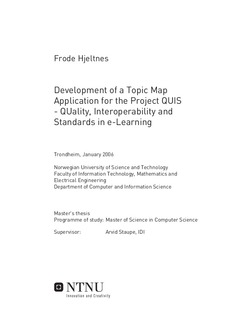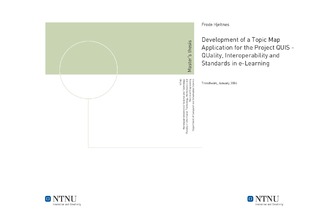| dc.description.abstract | QUality, Interoperability and Standards in e-Learning (QUIS) is an EU funded project, and is a part of the e-Learning program . The projects contract number within the e-Learning program is 2004-3538/001-001 ELE-ELEB14. The project has partners from Norway, Sweden, Italy and Hungary. This thesis is written to be a part of the projects? Work Package 5 ? ?Standards for e-Learning?.
A topic map is an information structure for describing and identifying resources. It consists of the major elements topics, occurrences and associations. A topic is the representation of a real world subject. An occurrence is a source of information about the topic. Internal occurrences are information sources within the topic map file. External occurrences are links to resources located elsewhere. An association is a relationship between topics. It describes how the topics are related to each other, by giving the different members of the association ?roles?.
All topic map elements can be scoped to give them extra semantic value. Two or more topic maps can be merged to form one large topic map. Topic maps usually follow the XML for Topic Maps (XTM) standard.
In addition to being an information structure, the topic map standard also tries to overcome the so called ?Web Identity Crisis?. The Web Identity Crisis is based on the statement that ?there is no way of knowing what references on the World Wide Web identify today?.
The Semantic Web is a similar technology to topic maps. It is based on the Resource Description Framework.
QUIS topic map is a topic map made to represent subjects in the area of e-Learning standardization. It is made in a ?topic map constructor system? based on the Topic Map 4 Java API. A ?topic map application system? can be used to display the content of the topic map. It is shown that this approach offers easy and structural access to subjects within this area of interest. In comparison with regular web portals, the topic map application has several advantages:
? The connection between related information is more intuitive.
? The topic map is easier to maintain extend.
? The topic map has better support for multiple languages.
? The topic map can be merged with other topic maps.
In order to exploit the full strengths of the topic map standard, more e-Learning communities have to take it into use. The creation of Published Subject Identifiers (PSI) will advance this process. | |

